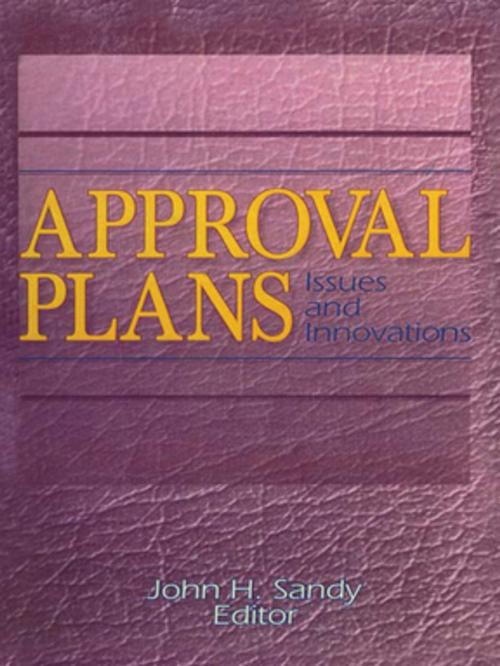Approval Plans
Issues and Innovations
Nonfiction, Reference & Language, Language Arts, Library & Information Services| Author: | Linda S Katz, John H Sandy | ISBN: | 9781317951025 |
| Publisher: | Taylor and Francis | Publication: | October 18, 2013 |
| Imprint: | Routledge | Language: | English |
| Author: | Linda S Katz, John H Sandy |
| ISBN: | 9781317951025 |
| Publisher: | Taylor and Francis |
| Publication: | October 18, 2013 |
| Imprint: | Routledge |
| Language: | English |
How can you, as an acquisition librarians, keep current on the output of hundreds of publishers? The answer, of course, is that you cannot. For over 30 years, approval plans have been used by librarians to acquire current titles, save staff time, and build core collections. Even today, these reasons seem appropriate, as libraries try to maintain up-to-date collections and control personnel and operating budgets. However, as shown in Approval Plans: Issues and Innovations, the use of approval plans is not so simple and straightforward; their use is subject to complex procedures and policies--and even politics. This book presents research by librarians from academic libraries and professionals from approval vendors to give you necessary insight on the major approval plan issues and to show you some of the innovative approaches to solving the problems associated with approval plans.
Unfortunately, approval plans are not as simple as creating a “needs” profile and receiving the books that match that profile from an approval vendor. Problems and questions invariably arise. If you are in acquisitions and collection development or administration, it is particularly important that you explore the following questions posed in Approval Plans:
-
What mechanisms can reduce receipt of duplicate titles?
-
Do vendors see small college libraries as a viable market?
-
What role does technology play in improving approval plans?
-
What level of returns is acceptable?
-
Do the hidden operational costs of approval plans offset their benefits? Approval Plans is full of useful information that will show you how to save time and money, improve collections, and utilize new technology. The book discusses such key issues as: the benefits of approval plans to public service vs. the costs to technical service; the call for refined profiles to help keep return rates low; proper management in key areas such as profile development, quality control, and plan maintenance; approval plan overlap; and vendor responsibilities. Innovations covered include: the call for introduction of approval plans to small college libraries; the possibility of “outsourcing” technical service functions with vendor-supplied cataloging and end-processing; the use of online services, World Wide Web, and the Internet to improve communication between vendors, publishers, and libraries; and a list of criteria to be considered when selecting an automated acquisitions system.
Approval Plans is especially useful and timely as libraries are considering the best ways for acquiring books during an era of declining materials budgets. This collection also has special importance, in a broader sense, to the many changes that are occurring in academic libraries today.
How can you, as an acquisition librarians, keep current on the output of hundreds of publishers? The answer, of course, is that you cannot. For over 30 years, approval plans have been used by librarians to acquire current titles, save staff time, and build core collections. Even today, these reasons seem appropriate, as libraries try to maintain up-to-date collections and control personnel and operating budgets. However, as shown in Approval Plans: Issues and Innovations, the use of approval plans is not so simple and straightforward; their use is subject to complex procedures and policies--and even politics. This book presents research by librarians from academic libraries and professionals from approval vendors to give you necessary insight on the major approval plan issues and to show you some of the innovative approaches to solving the problems associated with approval plans.
Unfortunately, approval plans are not as simple as creating a “needs” profile and receiving the books that match that profile from an approval vendor. Problems and questions invariably arise. If you are in acquisitions and collection development or administration, it is particularly important that you explore the following questions posed in Approval Plans:
-
What mechanisms can reduce receipt of duplicate titles?
-
Do vendors see small college libraries as a viable market?
-
What role does technology play in improving approval plans?
-
What level of returns is acceptable?
-
Do the hidden operational costs of approval plans offset their benefits? Approval Plans is full of useful information that will show you how to save time and money, improve collections, and utilize new technology. The book discusses such key issues as: the benefits of approval plans to public service vs. the costs to technical service; the call for refined profiles to help keep return rates low; proper management in key areas such as profile development, quality control, and plan maintenance; approval plan overlap; and vendor responsibilities. Innovations covered include: the call for introduction of approval plans to small college libraries; the possibility of “outsourcing” technical service functions with vendor-supplied cataloging and end-processing; the use of online services, World Wide Web, and the Internet to improve communication between vendors, publishers, and libraries; and a list of criteria to be considered when selecting an automated acquisitions system.
Approval Plans is especially useful and timely as libraries are considering the best ways for acquiring books during an era of declining materials budgets. This collection also has special importance, in a broader sense, to the many changes that are occurring in academic libraries today.















